Jules Verne’s legendary nautical science fiction tale was adapted in grand style by Universal, complete with underwater photography and billed as the “First Submarine Photoplay Ever Filmed” by the proud studio.
I will also be reviewing Disney’s 1954 version. Click here to skip to the talkie.
Take an ocean voyage, they said. It will relax you, they said.
Jules Verne is one of the fathers of science fiction and 20,000 Leagues Under the Sea is one of his most famous works. It has the rare distinction of being a science fiction story that has been downgraded to an adventure/drama due to the fact that many of the technological wonders that Verne included in his tale later became commonplace. But don’t forget that this was cutting edge technology in 1869.

(By the way, some people have described this book as a precursor to the steampunk genre. This is as ridiculous as saying that The Cabinet of Dr. Caligari was a precursor to Tim Burton’s career. It would be better to say that 20,000 Leagues Under the Sea influenced and inspired the steampunk genre. End pedantic rant.)
With any book this famous, essays and dissections abound. Since I have no wish to retread old ground and since my primary interest is cinematic, I will keep the book-to-film comparisons small and manageable, focusing instead on how the story works on the screen. Both 20,000 Leagues and its sequel, The Mysterious Island, had been filmed before this 1916 production and they would be filmed again and again and again. Let’s see how the 1916 motion picture measures up to the cinematic legacy of this famous story.
Our first hint that something big is afoot comes during the opening credits. Pioneering underwater photographers George and Ernest Williamson are given special billing right after the main title. The brothers, we are breathlessly promised, have alone solved the secret of under-the-ocean photography. I don’t know about you, but when something is given such a hard sell, I am inclined to sit back and demand to see the goods. The ball was in the Williamson’s court.
Of course, 20,000 Leagues Under the Sea needs more than just ocean photography and we are soon shown our main characters. Professor Aronnax (Dan Hanlon) lives with his unnamed daughter (Edna Pendleton). In the book, Aronnax had no daughter and his sidekick was his servant, Conseil, who just sort of lingers in the background in this adaptation. He has been replaced by the daughter, who is such an important character that the filmmakers couldn’t be bothered to give her a name. Hoo boy. I’ll just refer to her as Aronnaxette.

“Um, who are you again?”
Aronnax accepts the US government’s offer to try to track down a sea monster that has been destroying ships. He and his daughter board the Abraham Lincoln and make the acquaintance of harpooner Ned Land (Curtis Benton). Ned and Aronnaxette hit it off and it looks like love is in the air but don’t worry, absolutely nothing comes of it.

Now it’s time to meet the character we have all been waiting for: Captain Nemo. He is played by Allen Holubar, who is most famous today for directing (or, rather, misdirecting) The Heart of Humanity with a little help from Erich von Stroheim. Holubar’s direction was laughable in spots, such as calling on his leading lady/wife talk to squirrels, kiss socks and having a major character stuff bread in his pants. I am sorry to say that Holubar’s talents as an actor match his skills as a director.

Strike One: Captain Nemo is under a mountain of blackface makeup with white eyeliner. In the silent era, actor frequently applied their own makeup so I am comfortable blaming Holubar for his character’s ridiculous appearance. Strike Two: Holubar employs woe-is-me stage mannerisms that verge into caricature. Strike Three: No smolder. Captain Nemo is a dark, dangerous character, intelligent and murderous. A certain intensity is called for and Holubar simply cannot muster it.
But the introduction of Captain Nemo also means the introduction of the Nautilus, his submarine. I am happy to report that every word written about the Williamson brothers and their underwater special effects and photography is true. Simply put, the Nautilus is stunning. It’s sleek, it’s fast and it cuts through the water with suitable menace. The special effects are a century old and they are holding up. Color me impressed.
Of course, the Nautilus and the Abraham Lincoln meet on the high seas. The sailing ship puts up a gallant fight but is no match for the superior technology. Aronnax, Aronnaxette and Ned are all thrown overboard and end up being rescued by the Nautilus. They are locked up and Captain Nemo announces they can never, ever leave. So there.

So then Lieutenant Bond and his four Army scouts escape in their balloon whilst the enemy shoots and them and… Confused? That’s not surprising. The filmmakers have decided that one Verne novel is not enough and have decided to throw 20,000 Leagues Under the Sea’s sequel, The Mysterious Island, into the mix. So with no introduction at all, we are supposed to suddenly be following the adventures of Lt. Bond (played by Matt Moore, by the way) and company. Sigh.

They land on an island, a mysterious island (get it? get it?) that is occupied by, I kid you not, the Child of Nature (Jane Gail). She’s covered in really shoddy dark makeup and wears leopard skins and she’s just so in touch with nature that she is moved to dance. And by “dance” I mean she awkwardly lurches and twitches about the beach. The Child of Nature trope was pretty common in silent film with D.W. Griffith being a noted devotee. Leni Riefenstahl indulged in a stint of this characterization as well, most notably in The Holy Mountain. (Please note that I am pretty much good with anything that makes Leni look ridiculous.)

Anyway, Captain Nemo seems to be less of a half-mad genius bent on destructive vengeance and more of an ocean-based philanthropist. He sends a basket of goodies to the stranded men and even saves one of the soldiers who was separated from the rest. The lone African-American in the scouting team is the one who gets the frying pan and has to cook and serve the others. Sigh. (I’m doing a lot of that in this picture.)
But then we get more underwater stuff! Yay! It truly is the saving grace of the picture. Aronnax and company have all been reduced to a hive mind and they think Nemo is swell. The guys get to go playing under the waves while Aronnaxette stays behind and watches. Sigh. Again. But the underwater scenes are just wonderful! Feast your eyes:
The Child of Nature has fallen for Matt Moore (forgot his character’s name within a few paragraphs, can’t be bothered to look it up) but she has a mysterious past and you will never guess who her daddy is! (Yes. Yes, you will.) Will our divergent plots ever come together? Find out in 20,000 Leagues Under the Sea!
So, how does it hold up? As an adaptation, it’s pretty poor and none of the performers acquit themselves particularly well. Holubar’s central role makes him particularly deserving of score but Jane Gail is pretty bad too, always twitching and making funny faces at the camera. Such mugging leads me to wonder if she was a family friend of Universal boss Carl Laemmle. (The Mary Philbin casting technique.)

Further, Ned Land is reduced to a footnote and Conseil barely registers at all. In their rush to expand the cast, the screenwriters forgot about the main characters of the original story. (The AFI catalog credits the adaptation to the film’s director, Stuart Paton, who seems to have spent much of his career at Universal without much distinction.) Any adaptation that has the chutzpah to include a title card like this deserves a certain amount of ridicule:
However, none of this matters once the film leaves dry land and dives under the waves. The spectacular underwater cinematography and the impressive Nautilus are more than enough to make up for the other flaws of the picture. This production is epic and every inch looks expensive. I was particularly surprised by the elaborate sets of the Indian flashbacks in the film’s finale. The Indian sequences takes up only a few minutes of the film. I wonder if it made use of other sets Universal had lying around. A bit of creative redressing?

So, is this picture worth seeing? If you are at all interested in the history of cinematic special effects, it definitely is. But as entertainment… Well, it’s fun enough but the flaws are pretty distracting and the performances leave much to be desired. Still, I believe anyone interested in silent cinema should see it at least once.
Movies Silently’s Score: ★★
Where can I see it?
While there are several versions in print, I recommend the out-of-print Image edition. It features a delightful score by Alexander Rannie and Brian Benison, which makes the picture considerably more enjoyable.
 Ladies and gentlemen, we are about to pit two Jules Verne adaptations against each other! The 1916 epic will be challenged by the 1954 Disney classic! Which film will emerge the winner?
Ladies and gentlemen, we are about to pit two Jules Verne adaptations against each other! The 1916 epic will be challenged by the 1954 Disney classic! Which film will emerge the winner?
The Talkie Challenger: 20,000 Leagues Under the Sea (1954)

I have been looking forward to this review as I do not believe I have seen this film since I was seven years old or thereabouts. As a child of the 80s, all my friends had stacks of Disney films on VHS in those fat white plastic cases and 20,000 Leagues Under the Sea was in many of those collections. Truth be told, I didn’t care much for it. I loved that Peter Lorre had a role in it, of course, but so much of it was just old guys talking, Kirk Douglas being manic and James Mason being scary. (I found beards terrifying as a child, it’s a wonder I tolerated Commander Riker.)
Of course, seven-year-olds are not noted to be the most astute film critics and so I was interested to see if the film would appeal to the adult me.
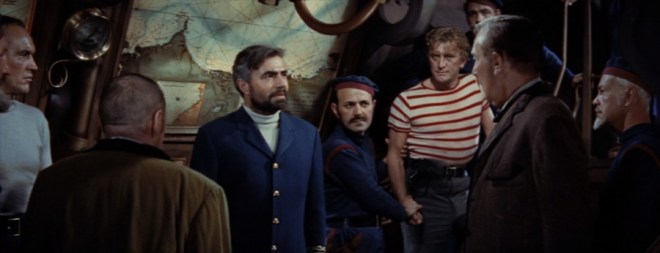
Long story short, yes it did. The Disney film’s high production values and huge budget make for a beautiful film, of course, but the real hero of the motion picture is the casting director. While there are minor characters in the background, this is basically a four-character story and all four are perfectly cast. Paul Lucas, Peter Lorre, Kirk Douglas and James Mason all inhabit their roles and illustrate different flavors of humanity. Lucas is a trusting intellectual with his head in the clouds, Douglas is a hedonist who solves most of his problems with either money or fists, Lorre is probably the most normal and would prefer a less colorful life. Mason’s take on Captain Nemo is iconic: dark and ruthless with a few tattered patches of humanity poking out now and again.
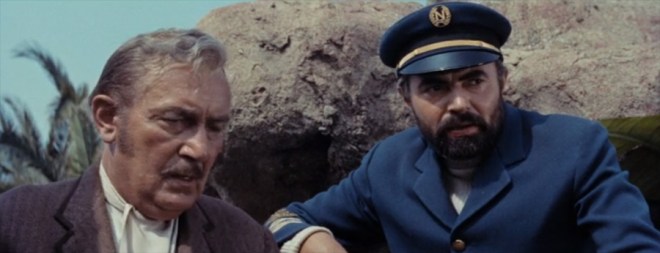
The set piece of the film is, of course, the attack of the giant squid and it is spectacular. The squid is swift, strong and hungry. The shots of the Nautilus crew trying to beat it off their hull are as good as anything in modern action films and Ned Land’s impulsive rescue of Nemo is grade-A heroism.
The film is not perfect by any means. It has major pacing issues and stops dead in certain spots. The idea of Nemo’s source of power being nuclear is just plain trying too hard. Cannibals? Seriously? They kept the cannibals? However, these issues do not take away from the fact that this is a first-rate production and what works does so very, very well.
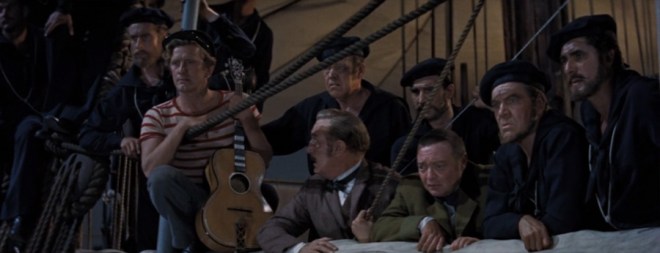
On a side note, I have heard some critics complaining about the casting of Mason as Nemo when the character was meant to be from India. Goodness know I am no fan of whitewashing roles but I think critics should really study up before making this charge against the 1954 film.
Nemo’s past and motives were kept murky in the novel, far murkier than in just about any film adaptation. Verne’s sequel, The Mysterious Island, revealed that Nemo haled from Britain’s Indian holdings and he carried a grudge against that empire. However, this was a change that Verne was persuaded to make by his publisher. Originally, Verne wanted to make Nemo a Polish nobleman who had been involved in the then-recent uprising against the Russians and Russia was the nation against which he held a grudge. Given the longstanding cultural affinity and diplomatic connections between France and Russia, the British Empire was a much more suitable villain for French readers.

Ironically enough, when the 1954 film entered production, the Russians would have been the fashionable villains of the time and the British would be the ally that the producers would hesitate to anger. In the end, the Disney production follows the novel’s lead and plays it coy; the enemy nation is never named.
For what it’s worth, the novel’s description of Nemo fits Mason pretty well:
“I made out his prevailing qualities directly: self-confidence—because his head was well set on his shoulders, and his black eyes looked around with cold assurance; calmness—for his skin, rather pale, showed his coolness of blood; energy—evinced by the rapid contraction of his lofty brows; and courage—because his deep breathing denoted great power of lungs.”
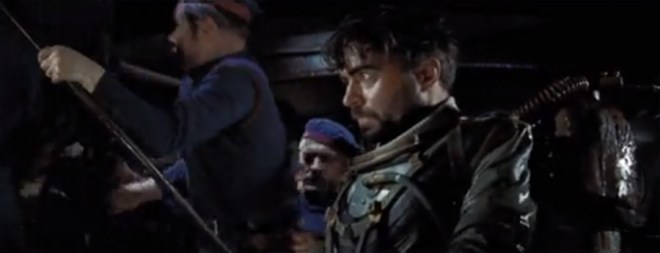
Since Nemo’s nationality was chosen to satisfying the political whims of a French publisher (and due to the fact that India and Poland both happened to have uprisings against colonial powers in the mid-1800s), well, I’m not particularly bothered with the casting of Mason. Polish or Indian backgrounds work equally well if we take into account author intent and I think we already have our hands full with the cannibal scene.

Now that that’s out of the way, it’s decision time! Let’s compare the components of the 1954 picture and the 1916 to determine the winner.
Nautilus: The 1916 film features better submarine vs. ship combat. The battle between the Abraham Lincoln and the Nautilus is fast-paced and quickly establishes that no matter was the Lincoln’s crew does, they are outmatched by superior technology. The 1916 Nautilus has a sleek, functional design and it speeds through the water with disturbing efficiency. While the 1954 film’s ramming scenes are effective and the undersea images of the defeated ships are eerie and memorable, the ship’s more baroque design is not quite as elegant. I’m going to have to give this one to the silent film.
Octopus/Squid Combat: I think we can settle this with two screen caps.


1954? 1954.
Underwater Photography: Both films are absolutely astonishing and their big budgets show but I am going to have to give this one to the 1916 film. It was made with far more primitive equipment but it still managed to capture the eerie beauty of the undersea world. The photography is truly a work of art.

Supporting Cast: The 1916 film suffers from a cast overload. First, we have the addition of a daughter for Aronnax and then we get the Child of Nature on the Mysterious Island, plus the crew of the military balloon, plus Denver, the man who betrayed Nemo back in the day. As a result, everyone who is not outrageously costumed is lost in the shuffle.
The 1954 film, on the other hand, creates an interesting conflict with the main trio. Paul Lucas’s idealistic Aronnax is an extreme intellectual, Kirk Douglas’s pragmatic Ned Land is all about the physical impulses of the moment and Peter Lorre’s Conseil vacillates between the two with his loyalty to his mentor conflicting with his admiration for Ned’s moxie. The film wisely leaves Nemo’s crew a cypher as the smaller cast allows for more depth in character development. We get a few colorful characters passing through but once the Nautilus shows up, it’s all about the trio and Captain Nemo.

Another thing: I am all for adding roles for women in films but the 1916 film and most of the versions made since have all felt the need to add daughters for Nemo, Aronnax or both. It’s clearly meant to add some romance and girl power to the story but the women are invariably appendages of either their fathers or designated love interests. Yawn. Call me when actual characters who happen to be women are involved. If you can’t do that, follow the Disney film’s lead and just stick to the book. Sigh.
With its leaner character roster and its smart casting, the 1954 version easily wins.

Captain Nemo: There’s no real competition here. James Mason was always at his best when he was able to engage his dark side and few 19th century adventure characters were darker and more mysterious than Captain Nemo. Allen Holubar’s theatrics are no match for Mason’s dark, smoldering performance. Holubar’s Nemo is a goofy eccentric while Mason’s is a terrifying force for vengeance. You tell me which actor you would rather see.

Further, the 1954 film does a far better job of selling Nemo’s tragic story. While the 1916 film has elaborate flashback sequences that show Nemo’s wife being killed and his daughter kidnapped, they cannot compete with Mason’s simple declaration that his wife and son were tortured to death. Less is indeed more.
And the winner is…
The Talkie!

While the 1916 film has impressive underwater sequences, its plot and characters are hopelessly muddled. The 1954 picture keeps it simple and only uses the main characters from the original Verne novel. While it is not a perfect film, it deserves its status as a classic live-action adventure.
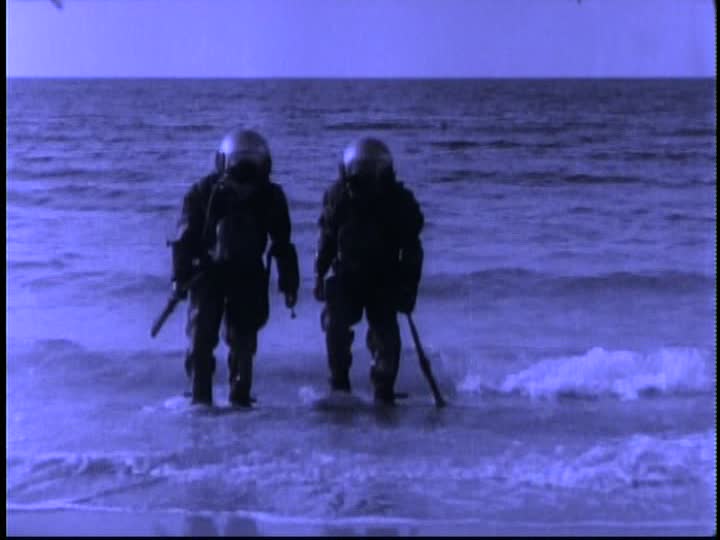













I would love to see the silent film version because of the great underwater sequences and the laughable acting from the wild eye gal and the black faced guy. These are great reviews. I love the 1954 version and felt James Mason was great as Nemo but I have a crush on Mason.
Yes, the acting is quite amusing, just not in the way it was intended! Crush or not, Mason is spectacular as Nemo.
I tried to watch the 1916 version, but couldn’t hack it,sorry. There was so much wrong about it. What does “steampunk” mean, please?
Steampunk is science fiction based on 19th century technology. So modern attempts to write in the Jules Verne style.
I liked Disney’s 20,000 Leagues Under the Sea when I was a kid. Seeing the Nautilus was the highlight of our one otherwise uneventful trip to Disney World back then.
I tried reading the book a few years ago, but it was full of a lot of techno-babble of the time. It reminded me of the time I tried to read Tom Clancy’s Clear and Present Danger. I didn’t need to know THAT much about mollusks or laser-guided bombs. So, I never got to the description of Captain Nemo. Now that I know it’s a lot easier to accept James Mason as him.
Yes, Verne was very much of his century as a writer and that’s either your cup of tea or it isn’t. Lengthy descriptions are probably the #1 reason why pre-20th century novels lose readers. For example, the whaling chapter of Moby Dick is cited as the least-read chapter in the whole English language. 😉
Exciting to see a talkie win! Proves that you’re not (totally) partial. I have a soft spot for the Disney Nautilus, because that ride at Walt Disney World was one of my favorites when I was little. I’m mixed on the movie, though, the singing actually does bother me, and I think Kirk Douglas looks awful in that shirt. Not as bad as Holubar, however, who I referred to as “an East Indian Santa Claus” in my review.
Well, in all fairness, I think the philosophy behind Douglas’s costume was to find a tight outfit and make it tighter. A little something for the ladies. 😉
Well, I can’t dispute that, but I think he’d look better with no shirt at all. Candy-stripe just isn’t his color!
Oh, he had a few of those scenes too 😉